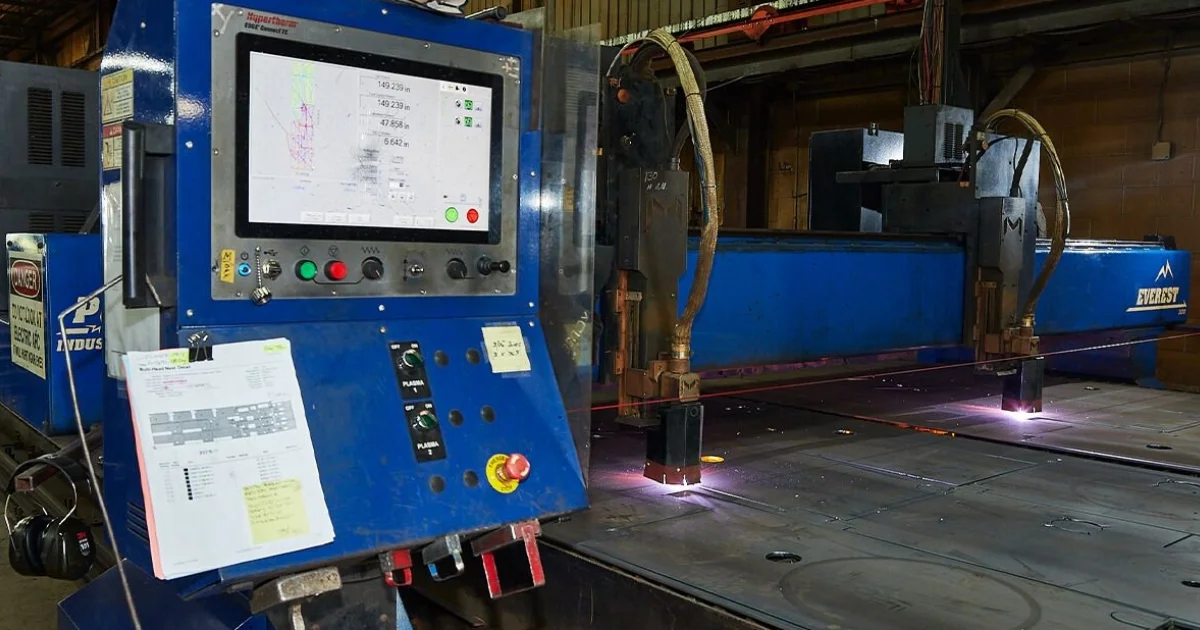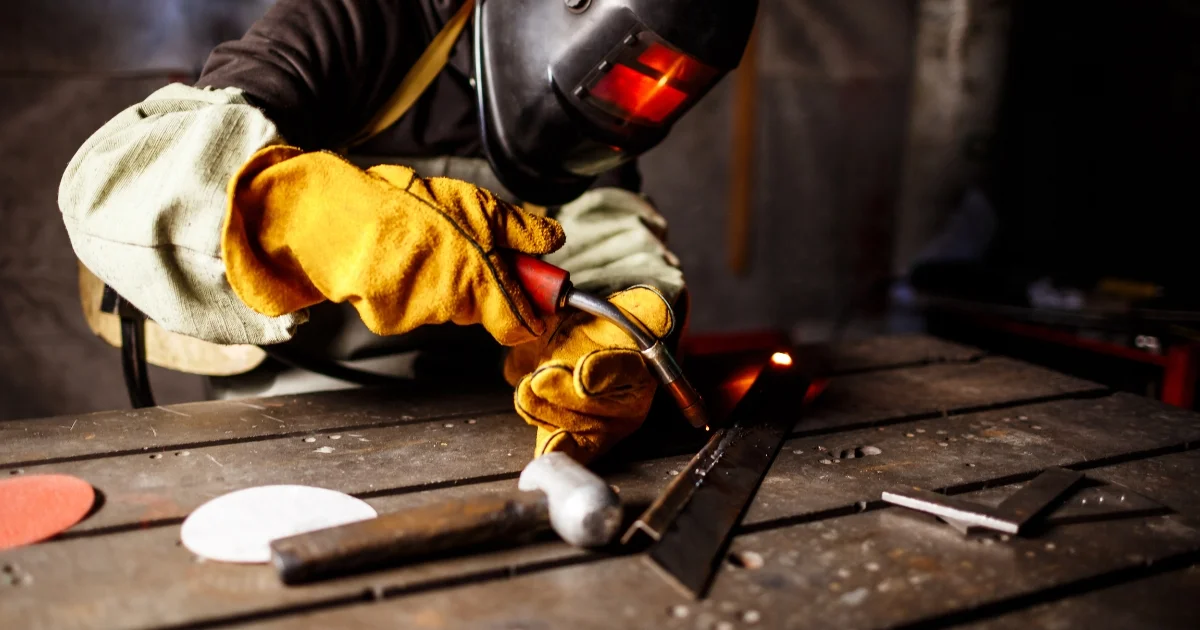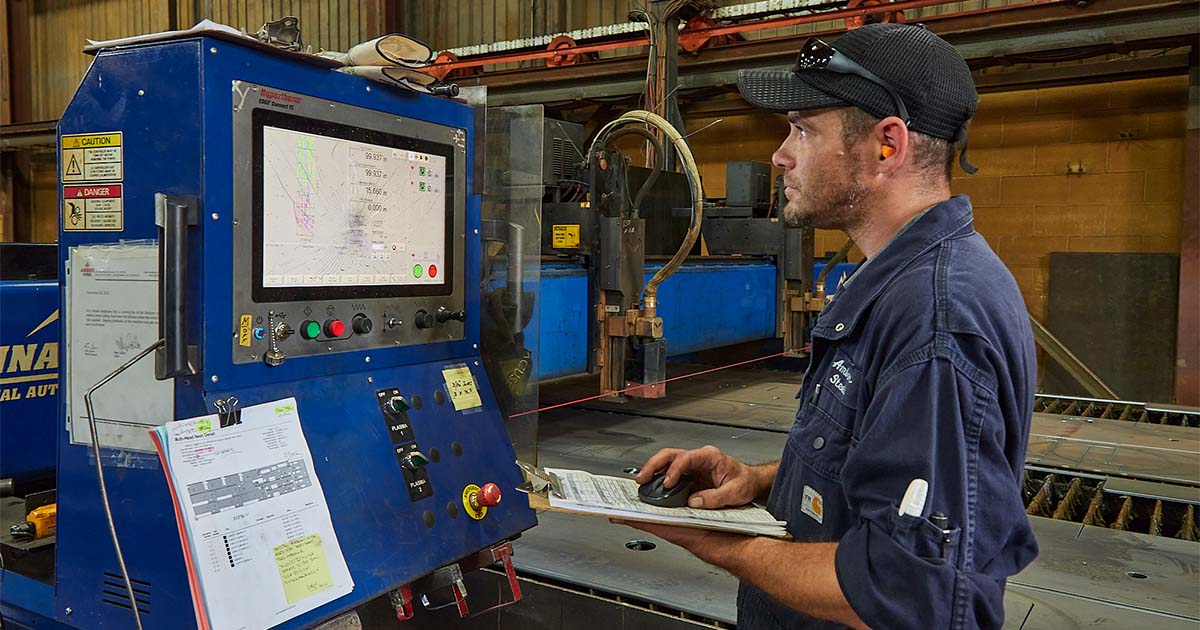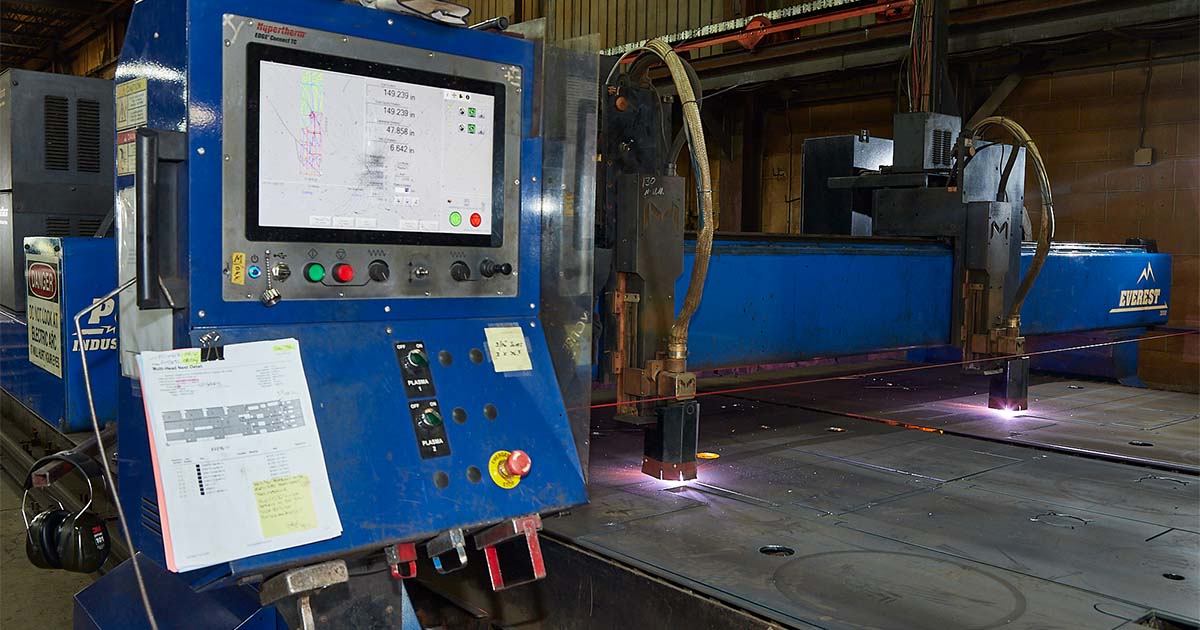
We collect basic website visitor information on this website and store it in cookies. We also utilize Google Analytics to track page view information to assist us in improving our website.
If you’re passionate about metal cutting or just keen to learn more, you’ve landed in the right place.
For over 38 years, Amber Steel has been at the forefront of metal cutting services, specializing in laser cutting, flame cutting, and plasma cutting. Our expertise has carved a niche in this cutting-edge industry, delivering precision and excellence across industrial projects big and small.
In our blog, we’ll share a mix of useful tips, innovative applications, our thoughts on sustainability in steel cutting, and more. Expect stories from the cutting floor, insights into how our processes can streamline projects across industries, and a few lessons we’ve learned along the way.
While we keep some of our trade secrets under wraps, this blog is designed to offer valuable nuggets of wisdom that you simply won't find anywhere else. Whether you’re a professional in the industry or someone fascinated by the possibilities of metal cutting, you'll find something of value here.
So, stick with us as we delve into the finer points of metal work. We’re glad to share our insights and lead discussions that matter to our industry.
How precision metal cutting propels the aerospace industry, from constructing lighter frames to enhancing aerodynamics.
The role of advanced metal cutting in automotive manufacturing, driving innovations in vehicle design and efficiency.
All about the robust and versatile process of flame cutting, ideal for tackling thicker metals with precision and ease.
Discover the art of crafting metal furniture, where cutting techniques meet design to create both functional and aesthetic pieces.
A behind-the-scenes look at the mechanics of metal cutting technologies and the science that makes them tick.
Laser cutting is where extreme precision meets efficiency, allowing for intricate designs and clean finishes.
The critical role of precise steel cutting in developing reliable and intricate medical devices.
How steel cutting supports the oil and gas industry with components that withstand extreme environments and pressures.
Known for its speed and versatility, plasma cutting slices through conductive metals with hot plasma.
Safety first! Tips and insights on maintaining a safe environment while handling powerful metal cutting equipment.
The backbone of construction, where steel fabrication and cutting technologies create frameworks that shape skylines.
Sustainability
A look at sustainability in metal cutting, focusing on practices that reduce waste and conserve energy to protect our planet.

Cutting metal with precision used to mean hours of careful work. Not anymore. Modern metal shops use plasma cutting – a beam of superheated gas that cuts through steel with perfect accuracy every time.
Listen in any fabrication shop and you'll hear plasma cutters steadily working. These machines turn day-long cutting jobs into minutes of precise work. From shipyards to car factories, plasma cutting tackles jobs that would challenge any other method.
The technology has transformed manufacturing since its start in the 1950s. What began as a way to cut tough metals has evolved into a computer-controlled process that delivers unmatched precision. Today's plasma cutting systems handle everything from thin sheets to thick plates, clean or rusty metal, simple cuts to complex designs.
At Amber Steel, computer controls guide our plasma cutters with pinpoint accuracy. We handle steel plates up to 1.250" thick, with precision to +/- 0.040". Every cut meets exact specifications, perfect for both single parts and production runs. Our systems serve industries from construction to aerospace, delivering the quality modern projects demand.
Questions about plasma cutting? This guide shares what you need to know. For quick answers, visit our Plasma Cutting Service page.
Let's explore what plasma cutting can do.
Think of plasma cutting as a precision torch that runs hot enough to melt metal instantly. Using a superheated electrical arc, it cuts through steel, stainless steel, aluminum, and other metals with remarkable speed and accuracy.
If it conducts electricity, chances are plasma can cut it. Common materials include:
Mild steel
Stainless steel
Aluminum
Brass and copper
Our plasma systems handle everything from thin sheets to plates up to 1.250" thick. While some industrial systems can cut even thicker materials, this range covers most manufacturing and construction needs.
Plasma cutting shines where other methods fall short:
Slices through metal faster than traditional methods
Handles rusty or painted surfaces without problems
Costs less than laser cutting for thick materials
Creates clean cuts with minimal waste
Each has its sweet spot. Plasma cutting works better for thick materials, offering faster cuts at lower costs. Laser cutting excels with thin materials and intricate designs. Check out our detailed comparison in "Plasma Cutting vs. Laser Cutting."
Working with plasma cutting requires proper safety measures:
Protective gear (gloves, goggles, fire-resistant clothing)
Good ventilation to handle fumes
Fire safety equipment nearby

Our computer-controlled systems add extra safety while ensuring consistent cuts.
Want more details? Visit our complete Plasma Cutting FAQ page.
Plasma cutting looks nothing like it did in the 1950s. Those early machines were bulky and basic - think of switching from a flip phone to today's smartphones. That's how dramatic the changes have been.
Modern plasma cutters use computer controls and improved power systems to deliver:
Cutting speeds that old systems couldn't touch
Power that handles thicker materials with ease
Precision cuts with minimal heat damage to surrounding metal
At Amber Steel, we use the latest plasma cutting systems to stay ahead of industry demands. Want to learn more? Check out our blog post "Exploring the Evolution of Plasma Cutting Technology."
Manufacturing teams often ask us about scaling up their cutting operations. What makes plasma cutting stand out is its sweet spot between speed and precision. Think assembly lines churning out identical parts, hour after hour.
Here's why manufacturers choose plasma cutting for large-scale production:
Production cycles that keep pace with demanding schedules
Less waste means lower costs per part
Flexibility to switch between custom work and mass production
At Amber Steel, our computer-controlled systems ensure every cut matches the first one, whether you need ten parts or ten thousand. Each piece meets exact specifications, keeping your production line moving.
Want to learn more about scaling up? Read our blog post "Power Up Your Production with Plasma Cutting at Scale."
Edge quality can make or break a project. While plasma cutting is fast, getting those perfect edges takes more than just hitting the start button.
Three key factors determine edge quality:
Machine setup – Getting the right gas pressure and power settings
Cutting speed – Moving too fast or slow creates rough edges
Equipment care – Fresh nozzles and parts cut cleaner than worn ones
At Amber Steel, our computer-controlled systems maintain ideal cutting conditions throughout every job. We monitor and adjust these factors constantly to deliver edges that meet or exceed industry standards.
Need more details about achieving clean cuts? Check out our guide "Plasma Cutting Tips for Achieving Clean Edges in Steel."
Flame cutting (also called oxy-fuel cutting) and plasma cutting both have their place in metal fabrication. Think of plasma cutting as a precision tool, while flame cutting is more like a heavy-duty workhorse. Both get the job done, but in different ways.
Here's how they stack up:
Plasma: Zips through metal like a hot knife through butter
Flame: Takes its time, especially on thick materials
Plasma: Computer control delivers exact cuts time after time
Flame: Works well but leaves rougher edges
Plasma: Handles nearly any metal that conducts electricity
Flame: Sticks mainly to carbon steel
Plasma: Links with computer systems for automated cutting
Flame: Needs more hands-on control and skill
Want a deeper dive into these differences? Read this comparison guide.
When it comes to metal cutting, plasma offers several green advantages. It wastes less material and uses energy more efficiently than older methods, but there are still environmental factors to consider.
Here's what matters for the environment:
Metal fumes need proper ventilation and filtering
Modern systems capture more particles than ever
Uses less energy than flame cutting
Needs both electricity and compressed gas to run
Precise cuts mean less scrap metal
Most cut material can be recycled
At Amber Steel, we take environmental responsibility seriously. Our ventilation systems exceed standards, and we optimize every cut to minimize waste. We also recycle all eligible scrap metal. Read our article if you want to learn more about the impact of plasma cutting.
Smart management of plasma cutting supplies makes the difference between profit and waste. Just like changing your car's oil on schedule keeps it running smoothly, maintaining plasma cutting components keeps cuts clean and costs down.
Key supplies to watch:
Nozzles and Electrodes: Replace before quality drops
Gas Supply: Choose the right gas for each job
Cutting Table: Keep it clean and well-maintained
At Amber Steel, we track component life and performance carefully. This attention to detail means better cuts and lower costs for our customers. Each part gets replaced at the right time - not too early, not too late.
Want to cut costs without sacrificing quality? Read our guide "Plasma Cutting Consumables: Efficiency and Cost Savings."
Safety comes first when you're working with equipment hot enough to melt steel. Proper protection and training prevent accidents and keep everyone healthy.
Every plasma cutting job requires:
Proper Gear: Safety glasses, heavy-duty gloves, and flame-resistant clothing
Clean Air: Strong ventilation systems that pull away metal fumes
Smart Systems: Computer-controlled cutting that keeps operators at a safe distance
At Amber Steel, safety isn't just a checklist – it's how we work every day. Our teams use the latest safety equipment and follow strict protocols that exceed industry standards. Check out this guide if you need more details about plasma cutting safety.
Metal fabrication depends on getting clean, accurate cuts through steel - and plasma cutting delivers. We designed this guide to cover everything from the basics to advanced techniques that help metal fabricators work faster and smarter.
When you watch a plasma cutter at work, you're seeing decades of technology in action. What started as bulky, basic machines in the 1950s has evolved into computer-controlled systems that cut with incredible precision. Today's plasma cutters handle everything from basic straight cuts to complex shapes, turning hours of work into minutes.
At Amber Steel, we put this technology to work every day. Our systems cut steel plates up to 1.250" thick with tolerances down to +/- 0.040". Behind these numbers stands our commitment to quality - making sure every cut meets exact specifications, whether for mass production or custom work.
We've covered a lot of ground in this guide – safety protocols, edge quality, cost management, and environmental considerations. Each topic helps you understand how plasma cutting fits into modern metal fabrication and why it often provides the best balance of speed, precision, and cost-effectiveness.
Need More Information?
Visit our Plasma Cutting page for quick answers
Check our blog for detailed guides on specific topics
Ready to put plasma cutting to work? Get in touch with Amber Steel today.

Plasma cutting is a versatile and widely used technique in industries such as metal fabrication, automotive, construction, and more. It involves using a high-velocity jet of ionized gas to melt through and cut various types of metal with precision and speed. Its efficiency and accuracy have made it a go-to method for achieving intricate cuts and shapes in metal materials.
However, as with any powerful tool, plasma cutting comes with real risks and hazards that cannot be ignored. While the benefits of this technology are significant, it's equally important to be aware of the potential dangers it can cause to workers, equipment, and the surrounding environment.
In this blog post, we will share more information on plasma cutting safety and explore the best practices that create a secure working environment. Whether you're an experienced professional or a novice in the field, understanding and implementing proper safety measures can make all the difference between a successful project and a disaster.
At Amber Steel, we specialize in laser, plasma and flame cutting, and have always been a "total source" service for the production of quality steel products. Quality is achieved by utilizing the right production technique for the right product. Our continual investment in equipment and technology enables us to offer clients many production alternatives to achieve exact product specifications and tolerances. If you’re interested in learning more about steel cutting or have a project in mind that you would need our expertise on, do not hesitate to reach out. We’re always one email or phone call away.
Understanding both the advantages and potential dangers of plasma cutting is essential for creating a safe and productive work environment. Workers can take the necessary precautions to minimize risks while operating plasma cutting equipment by understanding how it works and what to look out for.
Plasma cutting has found its place in numerous industries, including:
Metal Fabrication: It enables the creation of intricate shapes and designs in metals of varying thicknesses, making it indispensable for creating parts and components used in different products.
Construction: Plasma cutting is used to shape and cut metal sheets, beams, and pipes, essential in constructing buildings, bridges, and other structures.
Automotive and Aerospace: In these industries, precision cuts are required for manufacturing parts, frames, and components used in vehicles and aircraft.
Art and Design: Artists use plasma cutting to craft detailed metal sculptures and decorative pieces.
While plasma cutting offers tangible benefits, there are also safety rules that must be taken seriously:
Heat and Sparks: The intense heat generated during plasma cutting can lead to sparks, which pose a fire risk if not properly managed.
Fumes and Gases: Melting metal releases fumes and gases that are harmful to inhale. These can include toxic metals and other hazardous substances.
Electrical Hazards: Working with electrically conductive plasma and high-voltage equipment introduces the risk of electrical shocks or arcs.
Eye and Skin Protection: The intense light emitted during plasma cutting can damage unprotected eyes, and molten metal can splatter, causing burns if proper safety measures aren't in place.
Plasma cutting’s capabilities come hand in hand with potential risks that should not be underestimated. Prioritizing safety in plasma cutting is not just a recommendation — it's a critical necessity that can have far-reaching consequences for individuals, projects, and even entire organizations.
Plasma cutting involves the use of high temperatures, intense light, and electric currents, which introduce risks that need to be managed safely. Here’s how:
Fire and Burns: The extreme heat generated during plasma cutting can easily ignite nearby flammable materials. If not handled properly, sparks and molten metal can cause severe burns to operators and bystanders.
Inhalation of Hazardous Fumes: The process of cutting metal releases hazardous fumes and gases, which, when inhaled, can lead to respiratory problems, nausea, and long-term health issues. These fumes may contain toxic substances, depending on the type of metal being cut.
Eye and Skin Hazards: The bright arc produced during plasma cutting emits intense UV and infrared light that can damage unprotected eyes and skin. Proper eye protection and appropriate clothing are essential to prevent serious injuries.
Electrical Risks: Plasma cutters involve high-voltage electrical systems. Mishandling or improper grounding can result in electrical shocks or arcs, posing a significant danger to operators.
Needless to say, neglecting safety measures during plasma cutting can lead to a range of negative outcomes such as:
Injuries and Health Issues: Failure to use personal protective equipment (PPE) or neglecting safety protocols can result in injuries ranging from minor burns to serious accidents. Long-term exposure to hazardous fumes can lead to chronic health problems.
Damage to Equipment: Inadequate safety precautions can also damage the plasma cutting equipment itself. Overheating, mechanical failures, or electrical malfunctions caused by negligence can be costly to repair or replace.
Legal and Financial Consequences: Operating without proper safety measures not only jeopardizes the well-being of workers but also exposes companies to legal liabilities and potential lawsuits. Violations of safety regulations can lead to fines and damage to a company's reputation.
Work Interruptions: Accidents due to lack of safety can lead to work stoppages, impacting project timelines and deadlines. This can result in financial losses and disruptions to business operations.

When working in a hazardous industry, it’s important to have safety measures in place. By implementing these essential safety measures, workers can significantly reduce the risk of injuries, fires, and accidents during plasma cutting activities. These precautions create a safer environment for operators and those in the vicinity, promoting a more efficient and productive workflow while minimizing potential hazards.
Here are a few suggestions on how to accomplish that:
Detail the Necessary PPE: Personal protective equipment is a fundamental aspect of plasma cutting safety. It includes a range of items designed to shield workers from potential hazards. Necessary PPE for plasma cutting includes protective clothing, gloves, safety eyewear, and suitable footwear.
Protective Clothing: Workers should wear flame-resistant clothing to protect against sparks and molten metal. Clothing should cover the arms and legs completely to minimize skin exposure.
Gloves: Heat-resistant gloves are crucial to protect hands from burns and cuts. Gloves should have reinforced palms to withstand heat and sharp objects.
Safety Eyewear: Safety goggles or a welding helmet with appropriate shading are essential to shield the eyes from the intense light and UV radiation produced during plasma cutting.
Proper Ventilation and Exhaust Systems: Adequate ventilation is essential to remove fumes and gases generated during plasma cutting. An effective exhaust system prevents the accumulation of toxic fumes and ensures a healthier work environment.
Well-Lit and Organized Workspace: A well-lit workspace enhances visibility, reducing the risk of accidents. An organized work area minimizes the chances of tripping or coming into contact with hazards, ensuring a safer overall environment.
Clear the workspace of flammable materials that can catch fire from sparks or heat.
Keep a fire-resistant barrier or welding blanket nearby to shield surrounding objects.
Avoid cutting near combustible materials.
Workers should know the location and proper use of fire extinguishers.
Regular fire drills and knowledge of evacuation routes are crucial for a swift and safe response to emergencies.
Procedures allow everyone within an organization to understand and follow a set of rules that prioritize success, well-being and safety. Employees can significantly minimize risks associated with plasma cutting when consistently following safe operating practices. Here are some of the few we have in place at Amber Steel and also recommend.
Outline Pre-operation Checks: Before starting any plasma cutting operation, it's essential to conduct thorough equipment inspections. Check the condition of the plasma cutter, hoses, and cables. Ensure that all connections are secure and free from damage or wear.
Ensure Proper Functioning Equipment: Emphasize the importance of operating equipment that is in optimal working condition. Malfunctioning or damaged equipment increases the risk of accidents, which can be avoided through diligent pre-operation checks.
Handle electrical components and cords safely by:
Inspecting cords for fraying or damage before use.
Using ground fault circuit interrupters (GFCIs) for added protection.
Avoid running cords under carpets or through high-traffic areas.
Proper Grounding: Ensure the plasma cutter is grounded according to manufacturer guidelines to prevent electric shock hazards.
Avoid Wet Conditions: Do not operate plasma cutting equipment in wet or damp environments to prevent electrical accidents.
Disconnect Power: Always disconnect power when performing maintenance or making adjustments to the equipment.
Proper material handling is crucial to avoid accidents and ensure accurate cuts. Do so by:
Ensuring Stable Positioning: Ensure the material to be cut is securely positioned to prevent movement during cutting.
Avoiding Overreaching: Position the material so that operators don't need to overreach, maintaining stability and control.
Clamping: Use appropriate clamps to secure materials in place, ensuring they won't shift during cutting.
Anti-Slip Mats: Place anti-slip mats or flooring in the work area to prevent slips and falls, especially in areas where fluids may accumulate.
Safety is of utmost importance in every industry, but especially in metal cutting and manufacturing. We hope that by reading this blog post you’ve learned how to prioritize safety in plasma cutting operations through comprehensive guidelines covering personal protective equipment, workspace setup, equipment checks, and more. This will help you avoid risks and ensure a secure environment while optimizing productivity and well-being.
At Amber Steel, we specialize in laser, plasma and flame cutting, and have always been a "total source" service for the production of quality steel products. Quality is achieved by utilizing the right production technique for the right product. Our continual investment in equipment and technology enables us to offer clients many production alternatives to achieve exact product specifications and tolerances. If you’re interested in learning more about steel cutting or have a project in mind that you would need our expertise on, do not hesitate to reach out. We’re always one email or phone call away.